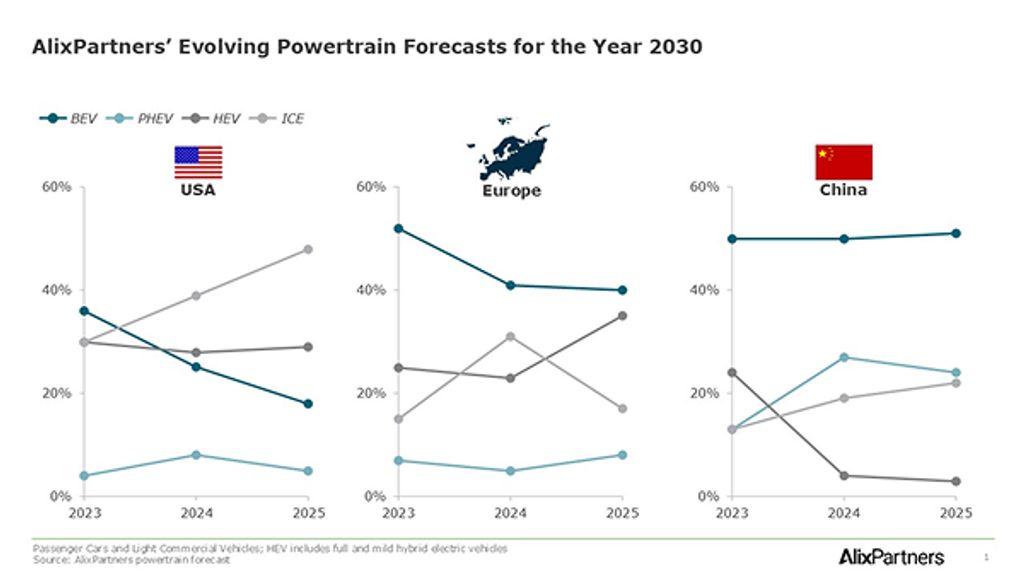- Capacity to build EV batteries far outstrips demand globally, a new report says.
- It’s worst in China, but the overcapacity issue exists in every major market and poses financial risks for battery makers.
- Material and production costs are still high, which means EVs often aren’t cheaper than gas cars, reducing demand.
The electric vehicle world has a new problem: too many batteries.
Capacity for building EV batteries outpaces demand for those batteries in every major market, a new report from consulting group AlixPartners claims. In North America, there is 1.9 times as much capacity as demand. In Europe, the capacity-to-demand ratio is 2.2.
And China, there is an absolutely stunning flood of capacity: 5.6 times as much battery-building capacity as there is demand for batteries. With tariffs restricting the country’s EVs and components from major markets, too, it’s a tenuous time to be a Chinese battery supplier. But, frankly, it’s not like things are going better in the rest of the world, as AlixPartners Senior Vice President Rohit Gujarathi explained to me.

EV battery manufacturing capacity far outstrips demand for EV batteries, putting the industry under pressure.
“At the industry scale, globally, really five times the demand versus three times the demand is not really very different. No matter where you go at this moment, the capacity is still way beyond what the demand is,” Gujarathi said in an interview. Because even if North American capacity looks better on paper, it is under-supplied in some ways. There’s very little local production of lithium-iron-phosphate batteries, for instance, which offer lower costs and better durability at the expense of density.
But there’s little incentive to build new capacity right now, as existing plants are already overbuilt for current demand, the report says. There are specific challenges that have driven overcapacity in specific markets: heavy incentive spending in China, the U.S.’s own EV incentives and the European Union’s aggressive regulations. Overall, though, a key factor has been that consumers just have not responded to surging electric options the way automakers, experts and regulators anticipated.
The main reason they haven’t, Gujarathi says, is cost.
A graph of projected demand for vehicle powertrain types.
Photo by: InsideEVs
“What consumers care about is: ‘What’s the price of the vehicle?'” he said.
“Does it make economic sense to me? The point of view right now is, in most cases, no, especially as a lot of government support has been taken away,” he added. Despite abundant supply pushing down prices, EV battery production and material costs remain high, and companies cannot sell them for less than they cost to build in the long term. Already, this instability is putting financial pressure on battery firms.
This comes as the U.S. has now removed its federal tax credit and rolled back emissions standards that pushed automakers to offer zero-emissions vehicles. The result will likely be a contraction in the EV market, but no one can quite say how big of a drop we’ll see. The numbers weren’t great last month, but they also reflect that many consumers pulled forward purchases to take advantage of the tax credit before it expired on September 30.
Regardless, a shrinking market won’t help the capacity-to-demand ratio. AlixPartners expects it to grow to 2.4 by 2028 and stay around that level through 2030. This reflects the firm’s earlier revision of North American EV penetration in 2030. Last year, it predicted that 36% of new vehicle shoppers in the U.S. would buy EVs in 2030. This year, it revised that figure down to 18%—a 50% drop in predicted demand.
The result will likely be further consolidation of existing battery plants and efforts, including deals like the one in which General Motors sold off its stake in a battery plant it once shared with LG Energy Solution. Gujarathi said he also expects to see companies launch LFP battery factories in the U.S. to address the cost problem.
This tracks, as we already know GM is putting North American LFP batteries in the new Chevy Bolt. But overall demand for these low-cost EVs remains unproven, so expect companies to stay agile. We’ve seen some companies try to divert EV battery production plans to make energy storage systems instead, for instance. But regardless of how exactly companies manage the excess supply, the uncertainty of today’s market is certain to impact the future of affordable EVs.

One silver lining: While EV battery demand wavers, the AI frenzy is driving up demand for battery energy storage systems (BESS). If battery companies have too many EV batteries, they could repurpose them to help balance the grid.
Photo by: LGES
“What this mean is holding back on some of the investments that may happen in the future,” Gujarathi said. Companies have to prepare to swap out technologies, battery chemistries and model plans as the situation develops.
“Everybody right now is in a holding pattern, because the ground is shifting underneath them,” he said. It may be like that for quite a while.
Contact the author: Mack.Hogan@insideevs.com


